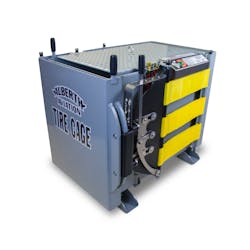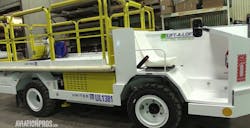In the aviation industry, the task of inflating an aircraft tire can be hazardous. If the tire is over-pressurized while being serviced, a violent overinflation failure can occur, causing damage to surrounding property and injuries to the technician – or even death.
Alberth Aviation’s Tire Inflation Cage was specifically developed and tested to contain an overinflation failure, a first in the aviation industry.
“In 1999, several customers had concerns about inflating wheel and tire assemblies with the retaining ring and split rim style design from some of the new aircraft models at the time,” says Rudy Alberth, president at Alberth Aviation. “After researching overinflation accidents and not finding a proof-tested product available for the aviation market, we designed, tested and manufactured the TC-36 which was delivered in 2004.
“Before our tire cages were developed,” he continues, “it was typical that products from the trucking industry were being used by some aviation maintenance personnel.”
However, Alberth Aviation’s destructive testing found the cages from the trucking industry were not a safe option for aviation wheels. The trucking industry tire cages provided no protection against the shrapnel resulting from a catastrophic overinflation failure.
The dual overlapping door design of the Alberth Aviation Tire Inflation Cage provides easy access, strength and protection. It is made in the USA with laminated steel plate construction. The double over-pressurization safety features are designed to prevent an overinflation from occurring. For ease of use, some key features are hands-free tire inflation, an external gauge panel with nitrogen fill port, and a bank vault style door latch assembly. The Tire Inflation Cage also includes three different quick disconnect fill fittings to fit various wheel fill port designs.
According to Alberth, the Tire Inflation Cage is the only designed and tested tire cage for the aviation industry proven to contain the debris if an overinflation accident should occur.
Two models of the Tire Inflation Cage are available.
“The original model TC-36 accommodates wheel and tire assemblies up to 36 inches in diameter,” Alberth says, adding when it was first introduced in 2004, the largest corporate aircraft at the time was the Gulfstream GV.
Alberth Aviation’s customers’ safety requests led the company to design the larger model TC-42 in 2016 to service wheel and tire assemblies up to 42 inches in diameter for large corporate aircraft such as the Gulfstream G650, Bombardier Global Express models, as well as some regional jets. The size of the wheel and tire assembly being serviced should be considered when determining which model is needed.
“An optional feature for the Tire Inflation Cage is the customer’s color choice,” Alberth says. “Custom colors have been popular for some of our customers that have signature corporate colors or unique logos that they want to present.”
When the Tire Inflation Cage is used inside a hangar or maintenance facility and kept clean, it is relatively maintenance free.
The Alberth Aviation Tire Inflation Cage is currently being used worldwide at hundreds of corporate flight departments, wheel and brake shops, factory service centers, independent maintenance facilities and military locations.
“Our customers have told us that our tire cages are easy to use and that they appreciate the safety features that they provide,” Alberth says. “Some companies have required them for their maintenance personnel’s safety.”






